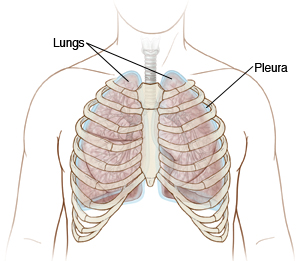You have pleurisy. This means the lining around your lungs (pleura) is inflamed or irritated. This usually happens when you have a buildup of fluid between the layers of the pleura. The pleura lines the lungs and the inside of your chest. This lining helps you breathe easier.
Pleurisy is most often caused by a viral or bacterial infection, such as tuberculosis or pneumonia. It can be caused by other conditions. It usually lasts up to 14 days depending on the cause. Pleurisy may cause sharp pain with deep breathing, coughing, sneezing, or movement. You can have shortness of breath.
You may be given antiviral medicines if a virus is causing the pleurisy. For a bacterial infection, you will be given antibiotics. Your health care provider may prescribe other types of medicine to help treat pleurisy. Take your medicines as prescribed.
Home care
The following tips will help you care for your condition at home:
-
Rest at home for the first 2 to 3 days if symptoms are severe. Don't let yourself get too tired when you resume activity. Ask your health care provider when you can go back to normal activities.
-
Don't smoke. Stay away from secondhand smoke.
-
Your provider will tell you which over-the-counter medicines to use to control pain. Talk with your provider before using other pain medicines if you have chronic liver or kidney disease or have ever had a stomach ulcer or digestive bleeding. Also, talk to your provider if you are taking medicine to prevent blood clots.
Don't give aspirin to children or teens unless your child’s doctor says it is safe. Aspirin can put your child at risk for Reye syndrome, a rare but serious condition.
Follow-up care
Follow up with your health care provider as advised.
When to get medical advice
Contact your health care provider right away if any of these occur:
-
Fever of 100.4ºF (38ºC) or higher, or as directed by your provider
-
Coughing up lots of colored sputum (mucus) or blood-tinged sputum
-
Redness, pain, or swelling of the leg
-
New symptoms develop
Call 911
Call
-
Increasing shortness of breath
-
Increasing chest pain, or pain that spreads to the neck, arm, or back
-
Coughing up blood
-
Confusion or dizziness
-
Lips or skin look blue, purple, or gray in color


